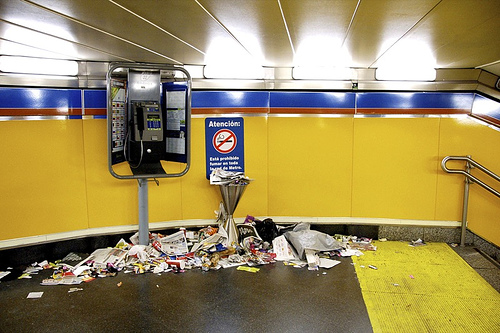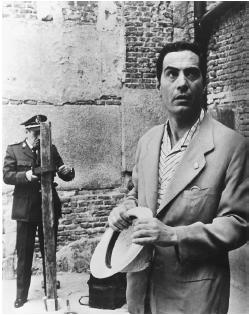I´m sitting in F and P’s living room. They were just robbed. Person or persons unknown broke into their Madrid apartment, stealing, among other things, their engagement rings. Pieces of the door’s lock scatter on the floor.
At this time of year Madrid is crisp and clear, with blue skies and little wind. Piles of fetid trash choke the entrances and hallways of the subway system: today the metro cleaners’ strike continues into its second week.
 [Madrid metro huelga de limpieza, from Sagasman’s flickr.]
[Madrid metro huelga de limpieza, from Sagasman’s flickr.]
The city — at least its outskirts, where I am now — is plastered with pseudopolitical stickers. The usual Spanish fascist graffiti has been supplemented by a much cannier strategy. Bigotry repackaged as national pride and anti-illegal-immigrant political groups. “Don’t be an ostrich!” goes one poster, accompanied by a child-friendly photomontage of a businessman with a bird’s head, “Face the dangers of illegal immigration.” Of course, these people make no distinction between legal and illegal immigration. “Housing for all SPANISH” goes another. Huge stickers adorn doorways, and if their rhetoric is (almost) subtle, the racist caricatures (eastern european, moroccan, black african, chinese) appeal to a more basic sense of literacy.
I don’t remember any of these stickers the last time I was here. Now they bloom like poppies. The spectrum fills with colors. Either post-Franco extremists have learned to groom themselves or someone lies adjacent. And it is cunning, to make immigration look like the spout from which all sorts of social and economic ills pour, and tie that to a throwback notion of ‘Spanish’ identity from the fascist 1970s. Watching cities slide. Feeling the climate change. Seeing the wrong people sharpen their marketing game.
But I was talking about robbery. About thieves. About a broken-hearted couple at the police commissioner’s. The news media is talking about a strange new thievery surrounding the assumption of robbery. It´s called the canon digital. This refers to a blanket fine levied upon all media and gadgets involved in possible music or film piracy. Starting on January 1st, the government will place a surcharge on everything from blank CD-rs to mobile phones, scanners, and hard drives. DSL internet lines may be next. The new Spanish intellectual property law assumes we all use all these items to make personal copies of copywritten media. A big assumption to say the least… Funds generated are meant to compensate for the cost of bootlegging. The money raised will go to the (already wealthy) SGAE, Spain´s national performance rights organization, who trickle out payment to labels and artists after recouping their considerable operating costs.
No, it doesn’t matter if you use USB drives for personal data, or purchase MP3s legally via iTunes, or if you run a copyleft netlabel… everyone must pay. The canon digital is built into the price, then taxed, upping the costs of digital storage media and playback devices even more. The canon adds about 38 cents per blank CD, roughly a 41% increase in total cost to consumer! Price list here. Nosoypirata (I’m not a pirate) blogs about these issues intelligently.
But I was talking about real thieves, the ones who enter your home, smash your sense of security, take the jewelry, make you wait for hours in the police commissioner’s to report a crime the cops will not solve.
I spent a year or so living beside the sea. The Mediterranean was literally a 2-minute walk from the flat (Barceloneta). On the corner stood another police commissioners’. In the summer months a line of people would stretch out onto the sidewalk — people in bathing suits and towels, who’d fallen asleep and gotten robbed of all they had with them at the beach.
Down the street from me (even closer to the sea!) was one of the saddest apartment’s I’ve ever been visited. Inhabited by a real live ILLEGAL IMMIGRANT, a black musician from Ghana who liked Steve Reich tape pieces *and* Deep Forest. My friend was sick and his place was dark, so dark, almost unbelievably dark, especially considering he rarely left and the sky outside glared bright and overwhelming, all horizon and space and tourists walking and swimming and eating as if a vacation is a narcotic or a dream. He’d microwave me tea.
Barcelona´s leaders are doing their utmost to ensure that the city won’t survive a sharp drop in tourism. (Paradox being that no city can survive a sustained spike in tourism, survival in the spiritual sense). And Spain itself can’t survive without its immigrants (legal or illegal) — economic survival as well as actual, demographic survival.
On F and P’s TV (too big for the thieves to carry) I’m watching a travel show about a blonde Spanish woman trying local cocktails around the world. That´s all she does. She jokes with the bartenders or resort staffers (they don’t always understand her, looking awkwardly at the camera) and drinks and drinks. Angkor Wat, St. Thomas, Rio de Janeiro. She bubbles through a shrinking world, looking truly drunk.
I switch channels. Jose Luis Moreno appears in a wheelchair. A few days ago real thieves entered his home. They beat him brutally. Like in 24, these thieves used torture to extract quality information in a hurry. If you have spent time in Spain yet don’t know Moreno, perhaps you’ve seen his TV program, Noche de Fiesta. It aired on Saturday evenings. Each episode lasted hours. I’ve watched it (briefly) several times: a variety show featuring models in bikinis, muscle boys, a lingerie catwalk, treacly pianists, Moreno giving away gifts, and all the old people in the audience clapping, clapping, clapping. A very successful show.
Survival of a species. Survival of the fittest. National survival. Survival of stuff like TV, befriending young and old and outlasting us all. For individuals never survive. The arrival of a new year means one less day. Which house to rob? Which love to defend?




